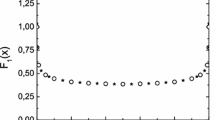Abstract
This paper considers the issue of Bose–Einstein condensation in a weakly interacting Bose gas with a fixed total number of particles. We use an old current algebra formulation of non-relativistic many body systems due to Dashen and Sharp to show that, at sufficiently low temperatures, a gas of weakly interacting Bosons displays Off-diagonal Long Range Order in the sense introduced by Penrose and Onsager. Even though this formulation is somewhat cumbersome it may demystify many of the standard results in the field for those uncomfortable with the conventional broken symmetry based approaches. All the physics presented here is well understood but as far as we know this perspective, although dating from the 60's and 70's, has not appeared in the literature. We have attempted to make the presentation as self-contained as possible in the hope that it will be accessible to the many students interested in the field.
Similar content being viewed by others
REFERENCES
M. H. Anderson, J. R. Ensher, M. R. Matthews, C. E. Wieman, and E. A. Cornell, Science 269, 198 (1995); K. Davis, M.-O. Mewes, M. R. Andrews, N. J. van Druten, D. S. Durfee, D. M. Kurn, and W. Ketterle, Phys. Rev. Lett. 75, 3969 (1995); C. C. Bradley, C. A. Sackett, and R. G. Hulet, Phys. Rev. Lett. 78, 985 (1997).
For a historical introduction to Bose condensation with references to the early literature on the weakly interacting Bose gas see A. Griffin, in the Proceedings of the International School of Physics “Enrico Fermi,” Course CXL, M. Inguscio, S. Stringari, and C. Wieman, eds. (IOP Press, Amsterdam, 1999).
F. Dafovo, S. Giorgini, L. P. Pitaevskii, and S. Stringari, Rev. Mod. Phys. 71, 463 (1999); see also, Proceedings of the International School of Physics “Enrico Fermi,” Course CXL, M. Inguscio, S. Stringari, and C. Wieman, eds. (IOP Press, Amsterdam, 1999).
P. C. Hohenberg and P. C. Martin, Ann. Phys. (N.Y.) 28, 349 (1964); N. N. Bogoliubov, in Lectures on Quantum Statistics (Gordon 6 Breach, New York, 1970); see also, D. Forster, Hydrodynamic Fluctuations, Broken Symmetry and Correlation Functions (Benjamin, New York, 1975).
M. Lewenstein and L. You, Phys. Rev. Lett. 77, 3489 (1996); C. W. Gardiner, Phys. Rev. A 56, 1414 (1997); P. Villain, M. Lewenstein, R. Dum, Y. Castin, L. You, A. Imamoglu, and T. B. A. Kennedy, J. of Modern Optics 44, 1775 (1997); Y. Castin and R. Dum, Phys. Rev. A 57, 3008 (1998).
R. F. Dashen and D. H. Sharp, Phys. Rev. 165, 1857 (1968); see also D. H. Sharp, ibid 165, 1867 (1968); C. G. Callan, R. F. Dashen, and D. H. Sharp, ibid 165, 1883 (1968); J. Grodnik and D. H. Sharp, Phys. Rev. D 1, 1531 (1970); ibid 1, 1546 (1970). To our knowledge the field theoretic approach to Bose systems using collective fields was pioneered by N. N. Bogoliubov and D. N. Zubarev, Sov. Phys. JETP 1, 83 (1955).
V. N. Popov, Functional Integrals in Quantum Field Theory and Statistical Physics (Reidel, Dordrecht, 1983).
S. Sunakawa, S. Yamasaki, and T. Kebukawa, Prog. Theor. Phys. 41 919 (1969); D. D. H. Yee, Phys. Rev. 184, 196 (1969); B. Tsu-Shen Chang, J. Math. Phys. 12, 971 (1971); Phys. Rev. A 5, 1480 (1972); G. S. Grest and A. K. Rajagopal, Phys. Rev. A 10, 1395 (1974); A. K. Rajagopal and G. S. Grest, ibid 10, 1837 (1974).
O. Penrose, Phil. Mag. 42 1373 (1951); O. Penrose and L. Onsager, Phys. Rev. 104, 576 (1956).
We note that, by contrast, symmetry breaking also implies ODLRO in the correlation function (1).
Here we will not consider fragmented condensates.
The operator \(\hat P = \Psi \left( {{\text{r}}} \right)\left[ {{1 \mathord{\left/ {\vphantom {1 {\hat n}}} \right. \kern-\nulldelimiterspace} {\hat n}}\left( {{\text{r}}} \right)} \right]\Psi ^\dag \left( {{\text{r}}} \right)\) is a projection operator \(\left( {\hat P^2 = \hat P} \right)\) with eigenvalues λ=0, 1. Since for any finite interaction no bosonic state can be annihilated by \(\hat P,\hat P \equiv {\hat l}\) on all states in the Hilbert space.
G. A. Goldin and D. H. Sharp, in Group Representations in Mathematics and Physics, Battelle Seattle 1969 Rencontres, V. Bargmann, ed. (Springer, New York, 1970); G. A. Goldin, J. Math. Phys. 12, 462 (1971); G. A. Goldin, J. Grodnik, R. T. Powers, and D. H. Sharp, J. Math. Phys. 15, 88 (1974).
G. Baym and C. J. Pethick, Phys. Rev. Lett. 76, 6 (1996).
S. Stringari, Phys. Rev. Lett. 77, 2360 (1996).
N. N. Bogoliubov, J. Phys. USSR 11, 23 (1947); for a recent review see, for example, A. L. Fetter, in the Proceedings of the International School of Physics “Enrico Fermi,” Course CXL, M. Inguscio, S. Stringari, and C. Wieman, eds. (IOP Press, Amsterdam 1999).
B. D. Josephson, Phys. Lett. 1, 251 (1962).
M. Ma and T.-L. Ho, J. Low Temp. Phys. 115, 61 (1999).
P. W. Anderson, Phys. Rev. 86 694 (1952).
Author information
Authors and Affiliations
Rights and permissions
About this article
Cite this article
Ruckenstein, A.E. Bose Condensation Without Broken Symmetries. Foundations of Physics 30, 2113–2124 (2000). https://doi.org/10.1023/A:1003745608929
Issue Date:
DOI: https://doi.org/10.1023/A:1003745608929



